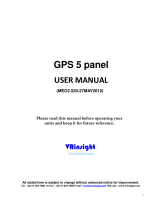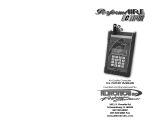
190-01325-00 Rev. A
Garmin G950 Pilot’s Guide for the Vulcanair P68
vii
TABLE OF CONTENTS
Entering a Transponder Code ..................................... 121
IDENT Function ........................................................ 122
Flight ID Reporting.................................................... 123
4.5 Additional Audio Panel Functions ..................... 124
Power-Up ................................................................. 124
Mono/Stereo Headsets .............................................. 124
Speaker ................................................................... 124
Intercom .................................................................. 125
Passenger Address (PA) System .................................. 127
Clearance Recorder and Player ................................... 127
Split COM Operation ................................................. 128
Entertainment Inputs ................................................ 129
4.6 Audio Panel Preflight Procedure ....................... 130
4.7 Abnormal Operation ........................................... 131
Stuck Microphone ..................................................... 131
COM Tuning Failure ................................................... 131
Audio Panel Fail-safe Operation ................................. 131
PFD Failure (Reversionary Mode) ............................... 131
SECTION 5 FLIGHT MANAGEMENT
5.1 Introduction ......................................................... 133
Navigation Status Box ............................................... 134
5.2 Using Map Displays ............................................. 136
Map Orientation ....................................................... 136
Map Range .............................................................. 138
Map Panning ............................................................ 140
Measuring Bearing and Distance ................................ 145
Topography .............................................................. 146
Map Symbols ........................................................... 149
Airways ................................................................... 155
Track Vector ............................................................. 157
Wind Vector ............................................................. 158
Nav Range Ring........................................................ 159
Fuel Range Ring ....................................................... 160
Field of View (SVS) .................................................... 161
Selected Altitude Intercept Arc ................................... 162
5.3 Waypoints ............................................................. 163
Airports ................................................................... 164
Intersections ............................................................ 171
NDBs ....................................................................... 173
VORs ....................................................................... 175
User Waypoints ........................................................ 177
5.4 Airspaces .............................................................. 183
5.5 Direct-to-Navigation ..........................................187
5.6 Flight Planning ..................................................... 193
Flight Plan Creation .................................................. 194
Adding Waypoints to an Existing Flight Plan ................ 199
Adding Airways to a Flight Plan ................................. 201
Adding Procedures to a Stored Flight Plan .................. 204
Flight Plan Storage ................................................... 211
Flight Plan Editing .................................................... 213
Along Track Offsets ................................................... 216
Parallel Track ............................................................ 217
Activating a Flight Plan Leg ....................................... 220
Inverting a Flight Plan ............................................... 222
Flight Plan Views ...................................................... 223
Closest Point of FPL .................................................. 225
5.7 Vertical Navigation ............................................. 226
Altitude Constraints .................................................. 228
5.8 Procedures ...........................................................232
Departures ............................................................... 232
Arrivals ................................................................... 235
Approaches ............................................................. 237
5.9 Trip Planning ........................................................ 243
Trip Planning ............................................................ 243
5.10 RAIM Prediction................................................... 247
5.11 Navigating a Flight Plan ..................................... 251
5.12 Abnormal Operation ........................................... 279
SECTION 6 HAZARD AVOIDANCE
6.1 XM WX Satellite Weather ................................... 282
Activating Services .................................................... 282
Using XM Satellite Weather Products .......................... 283
6.2 Airborne Color Weather Radar .......................... 315
System Description ................................................... 315
Principles of Pulsed Airborne Weather Radar ............... 315
Safe Operating Distance ............................................ 320
Basic Antenna Tilt Setup ............................................ 320
Weather Mapping and Interpretation ......................... 322
Ground Mapping and Interpretation ........................... 335
System Status ........................................................... 336
6.3 WX-500 Stormscope ........................................... 337
Setting Up Stormscope on the Navigation Map ........... 337
Selecting the Stormscope Page .................................. 341























